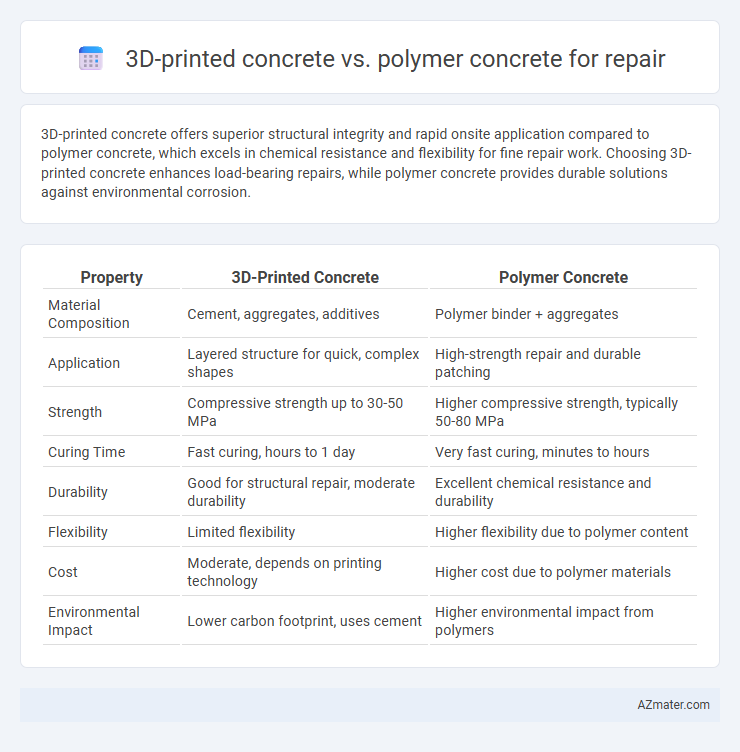3D-printed concrete offers superior structural integrity and rapid onsite application compared to polymer concrete, which excels in chemical resistance and flexibility for fine repair work. Choosing 3D-printed concrete enhances load-bearing repairs, while polymer concrete provides durable solutions against environmental corrosion.
Table of Comparison
| Property | 3D-Printed Concrete | Polymer Concrete |
|---|---|---|
| Material Composition | Cement, aggregates, additives | Polymer binder + aggregates |
| Application | Layered structure for quick, complex shapes | High-strength repair and durable patching |
| Strength | Compressive strength up to 30-50 MPa | Higher compressive strength, typically 50-80 MPa |
| Curing Time | Fast curing, hours to 1 day | Very fast curing, minutes to hours |
| Durability | Good for structural repair, moderate durability | Excellent chemical resistance and durability |
| Flexibility | Limited flexibility | Higher flexibility due to polymer content |
| Cost | Moderate, depends on printing technology | Higher cost due to polymer materials |
| Environmental Impact | Lower carbon footprint, uses cement | Higher environmental impact from polymers |
Introduction to 3D-Printed Concrete and Polymer Concrete in Repair
3D-printed concrete offers precise, layer-by-layer construction using cementitious materials, enabling rapid and customizable repairs in infrastructure with reduced labor and waste. Polymer concrete, combining polymer resins with aggregates, provides superior chemical resistance, adhesion, and mechanical strength, making it ideal for durable, high-performance repair applications. Both materials revolutionize repair techniques by enhancing structural integrity and extending the lifespan of repaired elements in construction and civil engineering projects.
Material Composition and Properties Comparison
3D-printed concrete primarily consists of cement, fine aggregates, water, and chemical admixtures, enabling precise layering with high compressive strength and enhanced durability, whereas polymer concrete is composed of a resin binder combined with aggregates, offering superior chemical resistance and flexibility. The cementitious matrix in 3D-printed concrete provides excellent load-bearing capacity, ideal for structural repair, while polymer concrete's thermosetting polymers ensure improved adhesion and reduced permeability, making it suitable for repairing corrosion-prone surfaces. Both materials exhibit rapid curing times but differ significantly in mechanical properties and environmental resilience, influencing their application choices in concrete repair projects.
Strength and Durability: Which Performs Better?
3D-printed concrete exhibits superior compressive strength and enhanced interlayer bonding, resulting in improved structural integrity compared to polymer concrete. Polymer concrete offers excellent chemical resistance and durability against environmental degradation, but its mechanical strength typically falls short of that achieved by 3D-printed concrete formulations designed for repair applications. For long-term repair projects demanding high load-bearing capacity and robustness, 3D-printed concrete generally outperforms polymer concrete in strength and durability metrics.
Flexibility and Adaptability for Various Repair Needs
3D-printed concrete offers superior flexibility by allowing precise customization of shapes and structures on-site, making it ideal for complex and irregular repair projects. Polymer concrete enhances adaptability through its excellent bonding strength and chemical resistance, ensuring durable repairs under diverse environmental conditions. Combining 3D printing technology with polymer-based materials further optimizes repair solutions by integrating the structural versatility of additive manufacturing with the resilient properties of polymers.
Speed and Efficiency of Repair Processes
3D-printed concrete accelerates repair processes by enabling rapid, layer-by-layer deposition with minimal curing time, significantly reducing project duration compared to traditional methods. Polymer concrete offers quick setting and high chemical resistance, facilitating fast repairs in aggressive environments but often requires meticulous surface preparation and limited repair thickness. The integration of 3D printing technology with polymer-based materials is advancing efficiency by combining precision application and fast curing for durable, time-saving structural repairs.
Environmental Impact and Sustainability Considerations
3D-printed concrete offers significant environmental benefits by reducing material waste, lowering carbon emissions through precise additive manufacturing, and enabling the use of recycled aggregates. Polymer concrete, while providing excellent durability and chemical resistance, often relies on non-renewable petrochemical resins that can increase the ecological footprint. Sustainable repair strategies increasingly favor 3D-printed concrete for its potential to utilize locally sourced sustainable materials and minimize energy consumption throughout the repair lifecycle.
Cost Analysis: 3D-Printed vs Polymer Concrete Repairs
3D-printed concrete repairs typically offer lower labor costs due to automation and faster application times compared to polymer concrete, which requires skilled manual installation. Material expenses for polymer concrete are generally higher because of specialized resins and additives, whereas 3D-printed concrete uses more conventional, cost-effective cementitious mixtures. Overall, 3D-printed concrete presents a more economical solution for large-scale or complex structural repairs, while polymer concrete may be financially justified for smaller, high-performance patching needs.
Real-World Applications and Case Studies
3D-printed concrete offers rapid construction and precise customization benefits in infrastructure repair, evident in projects like the restoration of bridge components in the Netherlands, showcasing enhanced durability and reduced downtime. Polymer concrete, utilized in road and pavement repairs in urban areas like Chicago, delivers superior chemical resistance and high tensile strength, making it ideal for environments exposed to harsh weather and heavy traffic loads. Comparative studies indicate 3D-printed concrete excels in geometric complexity and scalability, while polymer concrete provides longevity and resilience in chemically aggressive conditions.
Limitations and Challenges of Both Materials
3D-printed concrete faces limitations such as lower tensile strength and difficulties in achieving consistent layer adhesion, which can compromise structural integrity during repair applications. Polymer concrete, while offering better chemical resistance and durability, suffers from higher material costs and longer curing times that can delay repair projects. Both materials encounter challenges in scalability and ensuring compatibility with existing substrates, impacting their widespread adoption in repair scenarios.
Future Trends in Concrete Repair Technologies
3D-printed concrete offers precise layering and rapid on-site customization, making it a promising solution for complex structural repairs in urban infrastructure. Polymer concrete provides enhanced chemical resistance and high bond strength, ideal for durable repairs in aggressive environments such as industrial facilities and marine structures. Emerging trends indicate increased integration of smart materials and AI-driven printing techniques to optimize repair longevity and reduce maintenance costs across various concrete repair applications.

Infographic: 3D-printed concrete vs Polymer concrete for Repair
 azmater.com
azmater.com